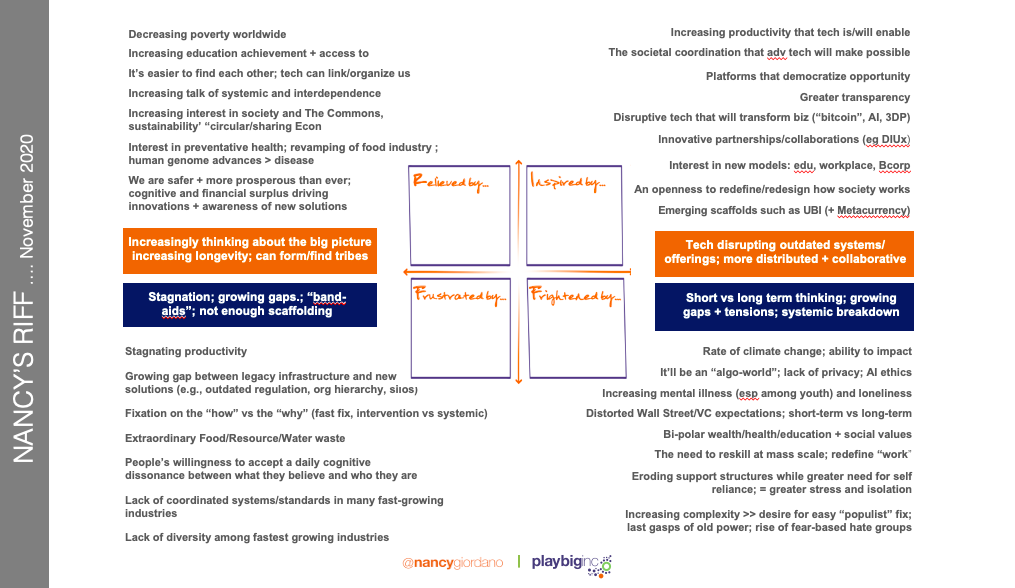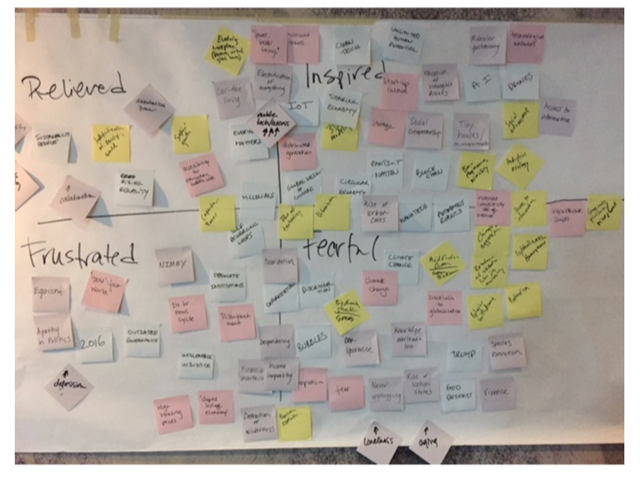When you talk with the technologists, designers and entrepreneurs actively building the future and ask how far along we are, you almost always hear we’re only one (maybe two) percent in. As mind-blowing as that feels if we’re only a percent or two in, it is clear we will be faced with new information and new possibilities at an astounding rate. As exponential curves grow, the longer you wait to explore, the more you will have to learn. What often keeps us on the sidelines, however, is an inability to make sense of it all. In a thoughtful read on how to tackle the world’s biggest issues, Swedish futurist Laurence Van Elegum points out the paradox: “We have come to expect simple solutions to ultra-complex problems.” So we wait for things to get clearer in order to know which side we should be on.
It is naïve—and even perilous—to believe the future is only good or bad. Hopefully, none of us is that blindly optimistic nor cynically pessimistic. Searching for a single black or white answer often draws us to polarizing pundits and puts us at greater risk in a world of interdependency and growing complexity. Especially when we’re being asked to respond, react, and innovate at a breathless pace.
Updating our understanding of new topics takes more than simple exposure to a big statistic or even an astounding example. Instead, engaging often requires that we hold two or more competing narratives about what this all means—and to rely on more than “thinking.” Making visible what we feel and what we believe creates the ability for a much richer form of “sense-making,” which in turn informs our ability to first interpret and then to act on what we think. Allowing for ambiguity while exploring our emotions and beliefs—including conflicting ones or those that seem illogical—enables us to freely wonder.
For example, are genetically modified foods bad for our health or the key to solving world hunger? Is remote learning the key to democratizing the next generation of learners or pushing students behind? Is capitalism today ensuring society’s strength or eroding it? Faced with complex, often contradictory beliefs, we often freeze and do nothing until we can be sure we are doing it “right.” But this paralysis isn’t necessary—or viable.
To help us find the value in these conflicting narratives, I developed a deceptively simple tool that teases out emotional distinctions. It is especially illuminating when used with a group. I call it the RIFF Model.
While it closely parallels the classic strategic SWOT (strengths, weaknesses, opportunities, and threats) analysis, in this case, we move from assessing our individual or organizational competitiveness to wrapping our arms around a more nuanced view of the future. It forces us to examine more closely what we—and ideally others—believe. Best of all, this mapping also gives us more insight into where we can uniquely put our energies: as a professional, a human, an organization, or even an industry.
I have used the RIFF Model with a wide range of audiences, from students to CEOs, and it’s interesting to see how different people use the tool. Most use it to reflect externally on industry and societal shifts they can see now and on the horizon (e.g., rising youth empowerment, the growth of cryptocurrencies, climate change, 3D printed food), and what they might build in response. Others, however, use the quadrants to write out their internal personal reactions about their own ability to move through the future (e.g., my broad network of relationships, lack of understanding about algorithms, the ability to enhance my education, lower barriers to starting my own company, etc.).
Use the illustration at the top of this blog post to create your own. Each quadrant corresponds with one of four specific emotions we feel when confronted with new information or observations about technology, society, business, or the future in general.
When I look at the future…
● What am I Relieved by?
● What am I Inspired by?
● What am I Frustrated by?
● What am I Fearful of?
I invite you to take a moment right now to write out your thoughts on each of the four RIFF questions. Think about this externally, draw a quadrant, and label each box with one of these emotions. In the top left, write out everything you’re relieved by. Devote the top right box to everything that inspires you about the future. In the bottom right, all the possibilities that frustrate you. And finally, in the bottom left, everything you’re afraid of for the future. Here's a sample of mine so you can see what it should look like...

In general, I have found this leads to three big insights:
First, as you look over your quadrants, what can you observe? Do more of your answers fall in one quadrant or another? If you had no trouble filling in tons of responses to the bottom two quadrants, you’re not alone. Many people are biased towards things that frustrate them and that they are fearful of, and we forget how things are also changing for the better. This informs our personal and/or organizational narrative of what we believe is (or is not) possible. If, overall, we believe the future is scary and or intractable, we are less likely to move forward. If, by contrast, we see things as more optimistic or balanced, we begin to see that we have a lot of resources and possibilities to draw on. In my personal RIFF, for example, I’m relieved by a shift to systemic thinking, and that I can easily find and connect with nearly any expert in the world.
Second, when you do this with a colleague or even a small team, you’ll see that what may inspire you actually frightens someone else. For example, 3D printing a house is great for those in the business of creating safe, affordable housing but is likely scary for a sheetrock manufacturer. This insight then creates much more empathy and the opportunity for a more compassionate response.
Recently, I was humbled to hear one participant in a RIFF session explain how even “empowered youth” could be something to be frightened by, saying: “If kids are raised with deep trauma or without good educations, they will have that much more power in their hands to make scary choices, both for themselves and society.” Wow! So true.
Thirdly, this means those bottom two quadrants offer a springboard for action. When we can honestly inventory the issues we are frightened about, we are then more motivated to redirect the impact they will have and instead create solutions. In my case, my fear of AI bias—and companion concern about the startling demographic homogeneity of data scientists and machine learning engineers—has me preaching non-stop about the critical need for diverse input on all AI endeavors and fueled my desire to found the Femme Futurists Society. A similar fear about growing anxiety among youth led me to pilot the Career Fair For the Future, where college and high school students could actively explore how new technologies will impact the careers that they are interested in—positively and negatively.
Taking time to develop this RIFF inventory liberates our thinking by giving us more than one camp (i.e., optimist vs. pessimist) to stand in. It also encourages us to wonder how others see things and to consider alternative opinions. Importantly, it helps us better see the unconscious narratives we carry that actively inform our actions. You shape what you believe is possible. In turn, you inspire what becomes reality.



